牛津译林七年级语法总结
- 格式:doc
- 大小:69.50 KB
- 文档页数:9
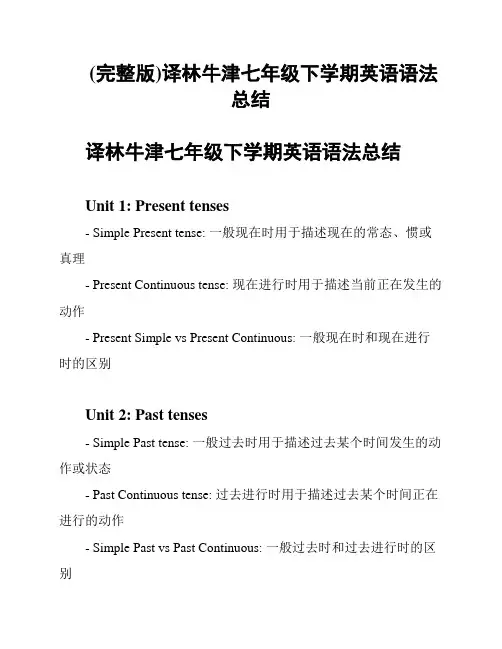
(完整版)译林牛津七年级下学期英语语法总结译林牛津七年级下学期英语语法总结Unit 1: Present tenses- Simple Present tense: 一般现在时用于描述现在的常态、惯或真理- Present Continuous tense: 现在进行时用于描述当前正在发生的动作- Present Simple vs Present Continuous: 一般现在时和现在进行时的区别Unit 2: Past tenses- Simple Past tense: 一般过去时用于描述过去某个时间发生的动作或状态- Past Continuous tense: 过去进行时用于描述过去某个时间正在进行的动作- Simple Past vs Past Continuous: 一般过去时和过去进行时的区别Unit 3: Future tenses- Will + verb: 表示将来的决定、打算或预测- Be going to + verb: 表示计划、意图或预测- Future Continuous tense: 将来进行时用于描述将来某个时间正在进行的动作- Future Simple vs Be going to: 将来时的两种表达方式的区别Unit 4: Passive voice- Active voice vs Passive voice: 主动语态和被动语态的区别- How to form the passive voice: 构成被动语态的方法- Passive voice with different tenses: 不同时态的被动语态形式Unit 5: Modal verbs- Can, could, may, might: 表示能力、允许或可能性- Must, have to: 表示必须、责任或推测- Should, ought to: 表示应该、建议或期望Unit 6: Conditionals- Zero conditional: 表示真理、自然法则或普遍情况- First conditional: 表示可能性、条件或可能的反应- Second conditional: 表示假设、不太可能的情况或对应的行动- Third conditional: 表示虚构、过去的假设或悔恨Unit 7: Reported speech- Reporting verbs: 常用的引述动词- Reporting statements: 直接引述陈述句的变化- Reporting questions: 直接引述疑问句的变化以上是译林牛津七年级下学期英语语法总结的内容。
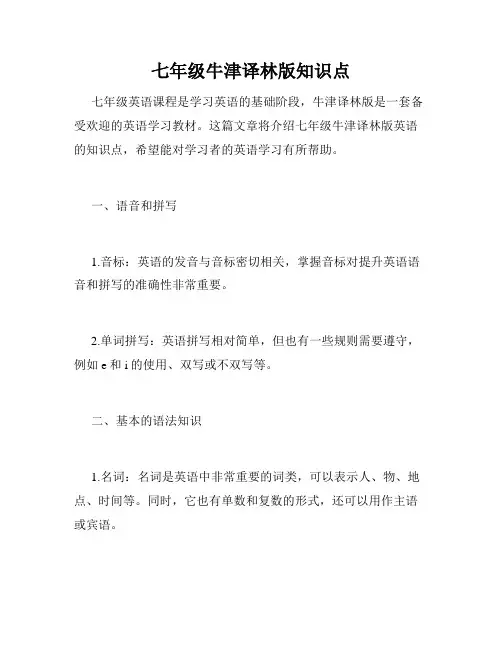
七年级牛津译林版知识点七年级英语课程是学习英语的基础阶段,牛津译林版是一套备受欢迎的英语学习教材。
这篇文章将介绍七年级牛津译林版英语的知识点,希望能对学习者的英语学习有所帮助。
一、语音和拼写1.音标:英语的发音与音标密切相关,掌握音标对提升英语语音和拼写的准确性非常重要。
2.单词拼写:英语拼写相对简单,但也有一些规则需要遵守,例如e和i的使用、双写或不双写等。
二、基本的语法知识1.名词:名词是英语中非常重要的词类,可以表示人、物、地点、时间等。
同时,它也有单数和复数的形式,还可以用作主语或宾语。
2.动词:动词在句子中通常作为谓语动词,表示动作、状态或事件。
还有一些特殊的动词形式,如动名词、不定式和分词。
3.形容词和副词:形容词和副词在英语中被广泛使用,形容词描述名词,而副词描述动词、形容词和其他副词。
三、基本的交流技巧1.口语:口语是英语学习的重要组成部分,要学会准确地发音和使用正确的语法结构。
2.阅读:阅读技巧包括提高阅读速度、理解文章的主要内容,并注意语法结构和生词的使用。
四、词汇量和理解能力1.单词和短语:学习英语时需要掌握大量的单词和短语,包括常用词汇、专业术语以及各种熟语和俚语。
2.学习理解:学习理解是一个重要的技能,包括根据上下文理解单词和短语的含义,还要学会提取文章的主旨和细节。
五、文化背景学习英语还需要了解英语国家的文化背景,包括文学、历史、宗教、音乐、体育等方面。
只有了解这些,才能更好地理解英语的使用和背后的文化。
总之,七年级牛津译林版英语知识点的学习是英语学习的重要基础,也是掌握日常英语的必要条件。
掌握上述知识点,并不断练习和运用,相信能够在英语学习过程中取得更好的成果。
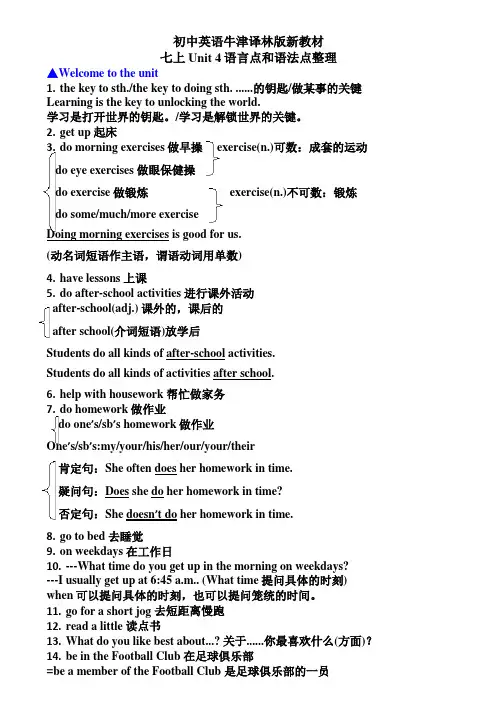
初中英语牛津译林版新教材七上Unit 4语言点和语法点整理▲Welcome to the unit1.the key to sth./the key to doing sth. ......的钥匙/做某事的关键Learning is the key to unlocking the world.学习是打开世界的钥匙。
/学习是解锁世界的关键。
2.get up 起床3.do morning exercises做早操 exercise(n.)可数:成套的运动 do eye exercises 做眼保健操do exercise 做锻炼 exercise(n.)不可数:锻炼do some/much/more exerciseDoing morning exercises is good for us.(动名词短语作主语,谓语动词用单数)4.have lessons 上课5.do after-school activities 进行课外活动after-school(adj.) 课外的,课后的after school(介词短语)放学后Students do all kinds of after-school activities.Students do all kinds of activities after school.6.help with housework 帮忙做家务7.do homework做作业do one’s/sb’s homework做作业One’s/sb’s:my/your/his/her/our/your/their肯定句:She often does her homework in time.疑问句:Does she do her homework in time?否定句:She doesn’t do her homework in time.8.go to bed 去睡觉9.on weekdays 在工作日10.---What time do you get up in the morning on weekdays?---I usually get up at 6:45 a.m.. (What time提问具体的时刻) when可以提问具体的时刻,也可以提问笼统的时间。
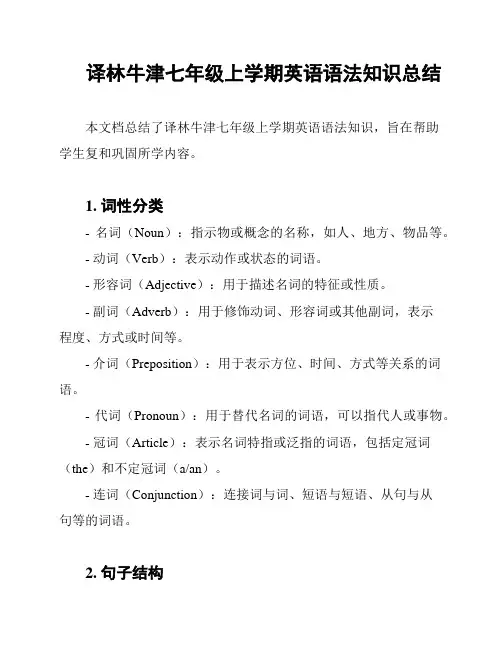
译林牛津七年级上学期英语语法知识总结本文档总结了译林牛津七年级上学期英语语法知识,旨在帮助学生复和巩固所学内容。
1. 词性分类- 名词(Noun):指示物或概念的名称,如人、地方、物品等。
- 动词(Verb):表示动作或状态的词语。
- 形容词(Adjective):用于描述名词的特征或性质。
- 副词(Adverb):用于修饰动词、形容词或其他副词,表示程度、方式或时间等。
- 介词(Preposition):用于表示方位、时间、方式等关系的词语。
- 代词(Pronoun):用于替代名词的词语,可以指代人或事物。
- 冠词(Article):表示名词特指或泛指的词语,包括定冠词(the)和不定冠词(a/an)。
- 连词(Conjunction):连接词与词、短语与短语、从句与从句等的词语。
2. 句子结构- 主语(Subject):句子中进行动作或被描述的人、事物或概念。
- 谓语(Predicate):句子中表达动作或状态的部分,通常是动词。
- 宾语(Object):动作的承受者或受益者,是动词的补充部分。
- 定语(Attributive):用于修饰名词或代词的形容词、副词等。
- 状语(Adverbial):修饰动词或整个句子的副词、介词短语等。
3. 时态与语态- 时态(Tense):表示动作发生的时间,如一般现在时、过去时、将来时等。
- 语态(Voice):表示动作的主体和动作所受的影响关系,如主动语态和被动语态。
4. 句型结构- 简单句(Simple Sentence):只包含一个主语和一个谓语的句子。
- 并列句(Coordination Sentence):由并列连词连接的两个或多个简单句。
- 疑问句(Question Sentence):用于提问的句子,通常以疑问词开头或动词倒装。
以上是关于译林牛津七年级上学期英语语法知识的简要总结。
希望这份文档能够帮助你更好地复习和应用所学的语法知识。
祝你学习进步!。
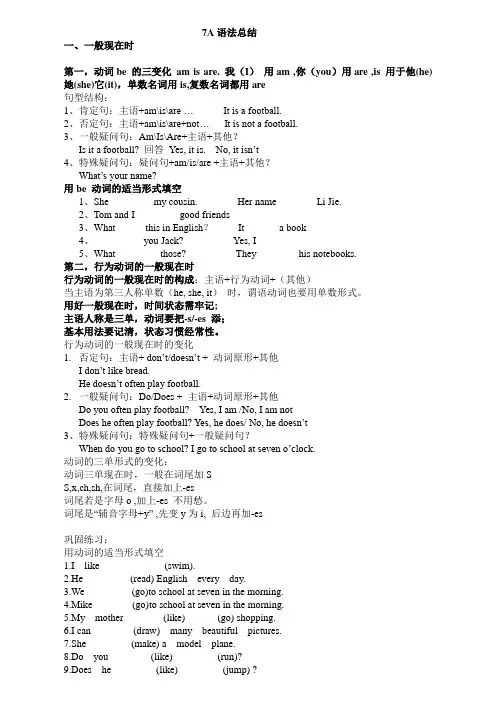
7A语法总结一、一般现在时第一,动词be 的三变化am is are. 我(I)用am ,你(you)用are ,is 用于他(he)她(she)它(it),单数名词用is,复数名词都用are句型结构:1、肯定句:主语+am\is\are … It is a football.2、否定句:主语+am\is\are+not… It is not a football.3、一般疑问句:Am\Is\Are+主语+其他?Is it a football? 回答Yes, it is. No, it isn’t4、特殊疑问句:疑问句+am/is/are +主语+其他?What’s your name?用be 动词的适当形式填空1、She ________ my cousin. Her name _______ Li Jie.2、Tom and I ________ good friends3、What _____ this in English?It ______ a book4、________ you Jack? Yes, I _______5、What ________ those? They ______ his notebooks.第二,行为动词的一般现在时行为动词的一般现在时的构成:主语+行为动词+(其他)当主语为第三人称单数(he, she, it)时,谓语动词也要用单数形式。
用好一般现在时,时间状态需牢记;主语人称是三单,动词要把-s/-es 添;基本用法要记清,状态习惯经常性。
行为动词的一般现在时的变化1.否定句:主语+ don’t/doesn’t + 动词原形+其他I don’t like bread.He doesn’t often play football.2.一般疑问句:Do/Does + 主语+动词原形+其他Do you often play football? Yes, I am /No, I am notDoes he often play football? Yes, he does/ No, he doesn’t3、特殊疑问句:特殊疑问句+一般疑问句?When do you go to school? I go to school at seven o’clock.动词的三单形式的变化:动词三单现在时,一般在词尾加SS,x,ch,sh,在词尾,直接加上-es词尾若是字母o ,加上-es 不用愁。
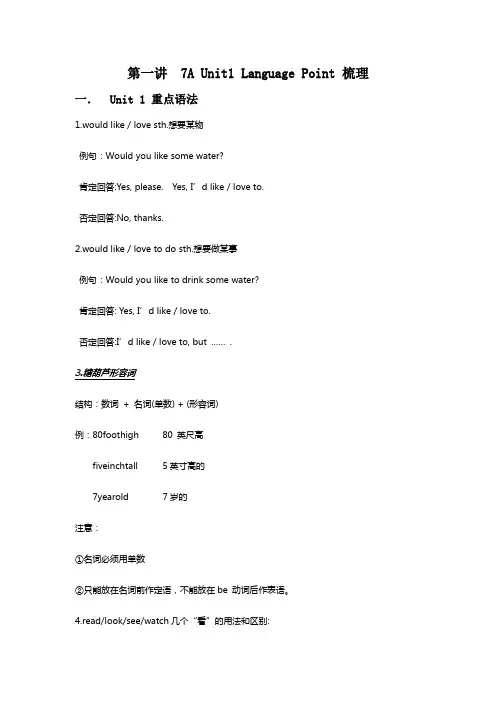
第一讲 7A Unit1 Language Point 梳理一.Unit 1 重点语法1.would like / love sth.想要某物例句:Would you like some water?肯定回答:Yes, please. Yes, I’d like / love to.否定回答:No, thanks.2.would like / love to do sth.想要做某事例句:Would you like to drink some water?肯定回答: Yes, I’d like / love to.否定回答:I’d like / love to, but …… .3.糖葫芦形容词结构:数词+ 名词(单数) + (形容词)例:80foothigh 80 英尺高fiveinchtall 5英寸高的7yearold 7岁的注意:①名词必须用单数②只能放在名词前作定语,不能放在be 动词后作表语。
4.read/look/see/watch几个“看”的用法和区别:look 强调看的动作①系动词。
译作看起来,后接形容词。
She looks happy.②不及物动词。
译作看,词组:look at…,用副词修饰。
Tom looked at me angrily.see 及物动词,译作看到,无进行时态,强调看的结果。
watch 及物动词,译作观看,注视。
强调观看正在进行中的,发生变化的活动过程,常用于看电视、看球赛、看演出等。
read 及物动词,译作阅读。
强调看文字内容的东西,常用于看书、看报纸、看杂志等。
5.疑问代词what、which、who 及疑问副词how、when 、where可以和动词不定式连用。
what to do 做什么which to do 做哪个who to do 如何做how to do 谁做when to do 什么时候做where to do 在哪里做6.“疑问词+ to do” 结构经常放在know,learn,see ,ask等动词后做宾语。
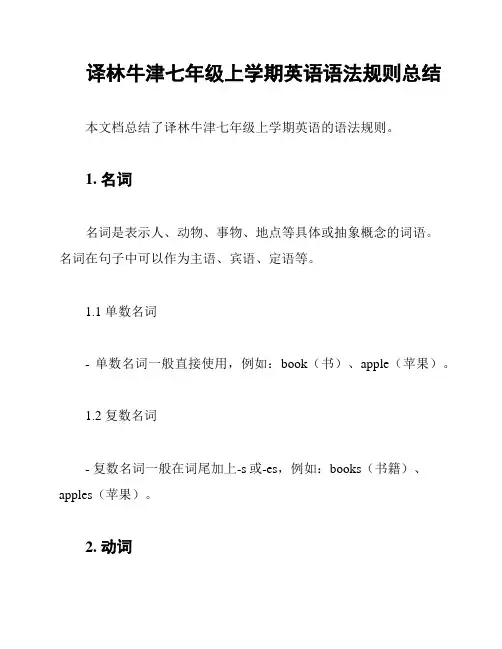
译林牛津七年级上学期英语语法规则总结本文档总结了译林牛津七年级上学期英语的语法规则。
1. 名词名词是表示人、动物、事物、地点等具体或抽象概念的词语。
名词在句子中可以作为主语、宾语、定语等。
1.1 单数名词- 单数名词一般直接使用,例如:book(书)、apple(苹果)。
1.2 复数名词- 复数名词一般在词尾加上-s或-es,例如:books(书籍)、apples(苹果)。
2. 动词动词表示动作或状态的词语。
动词在句子中可以作为谓语、宾语、定语等。
2.1 一般现在时- 一般现在时用于表示经常性或普遍性的行为或状态,例如:I go to school every day(我每天去学校)。
2.2 动词原形- 动词原形用于表示对某事物的普遍性描述,例如:Water boils at 100 degrees Celsius(水在100摄氏度烧开)。
3. 形容词形容词用于修饰名词或代词,表示人或事物的性质或特征。
3.1 形容词的比较级- 形容词的比较级用于比较两个人或事物的差异,例如:She is taller than me(她比我高)。
3.2 形容词的最高级- 形容词的最高级用于比较三个或更多人或事物的差异,例如:He is the tallest boy in the class(他是班级里最高的男孩)。
4. 副词副词用于修饰动词、形容词或其他副词,表示时间、地点、方式、程度等。
4.1 副词的用法- 副词可以修饰动词、形容词或其他副词,例如:She runs quickly(她跑得快)。
5. 介词介词用于表示人或事物在时间、地点、方式等方面的关系。
5.1 常见介词- 常见的介词有in(在)、on(在上面)、at(在...处)等,例如:He is studying in the library(他在图书馆研究)。
6. 冠词冠词用于限定名词。
6.1 定冠词- 定冠词用于表示特定的、已知的人或事物,例如:The book on the table is mine(桌子上的那本书是我的)。
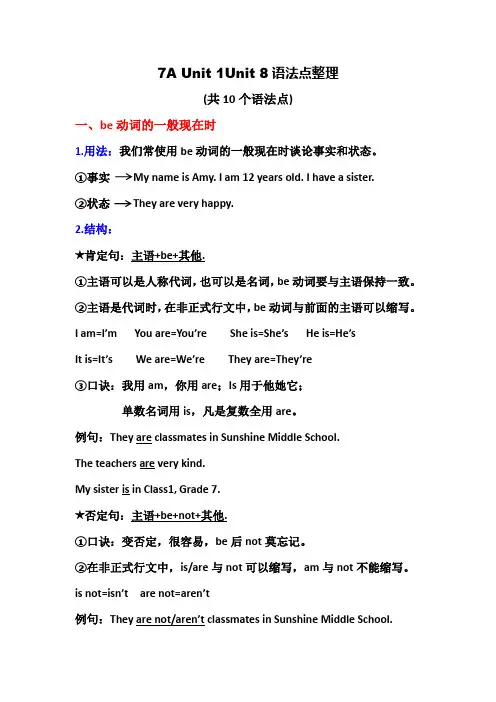
7A Unit 1Unit 8语法点整理(共10个语法点)一、be动词的一般现在时1.用法:我们常使用be动词的一般现在时谈论事实和状态。
①事实My name is Amy. I am 12 years old. I have a sister.②状态They are very happy.2.结构:★肯定句:主语+be+其他.①主语可以是人称代词,也可以是名词,be动词要与主语保持一致。
②主语是代词时,在非正式行文中,be动词与前面的主语可以缩写。
I am=I’m You are=You’re She is=She’s He is=He’sIt is=It’s We are=We’re They are=They’re③口诀:我用am,你用are;Is用于他她它;单数名词用is,凡是复数全用are。
例句:They are classmates in Sunshine Middle School.The teachers are very kind.My sister is in Class1, Grade 7.★否定句:主语+be+not+其他.①口诀:变否定,很容易,be后not莫忘记。
②在非正式行文中,is/are与not可以缩写,am与not不能缩写。
is not=isn’t are not=aren’t例句:They are not/aren’t classmates in Sunshine Middle School.My sister is not/isn’t in Class 1, Grade 7.★一般疑问句:Be+主语+其他?①口诀:变疑问,be提前,句末问号莫丢弃。
②在一般疑问句的肯定回答中不能用缩写形式。
③变一般疑问句时遇第一人称要变成第二人称。
例句:My sister is in Class1, Grade 7.(变疑问句,并作肯定和否定回答) Is your sister in Class1, Grade 7?Yes, she is.(不能缩写)/No, she is not(能缩写:No, she isn’t.).★特殊疑问句:特殊疑问词+be+主语+其他?例句:Where is your cousin from?二、行为动词的一般现在时1.用法:我们常使用行为的一般现在时谈论经常做的事情、目前的爱好、能力等以及不受时限的客观事实。
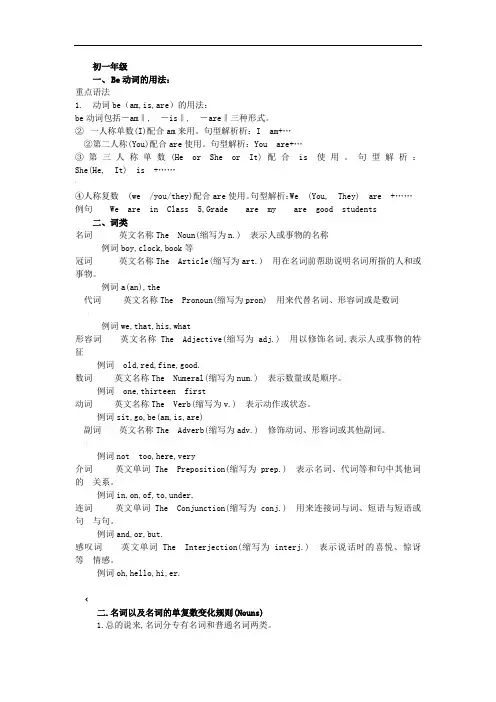
初一年级一、Be动词的用法:重点语法1. 动词be(am,is,are)的用法:be动词包括―am‖, ―is‖, ―are‖三种形式。
②一人称单数(I)配合am来用。
句型解析析:I am+…②第二人称(You)配合are使用。
句型解析:You are+…③第三人称单数(He or She or It)配合is使用。
句型解析:She(He, It) is +……'④人称复数(we /you/they)配合are使用。
句型解析:We (You, They) are +……例句We are in Class 5,Grade are my are good students二、词类名词英文名称The Noun(缩写为n.) 表示人或事物的名称例词boy,clock,book等冠词英文名称The Article(缩写为art.) 用在名词前帮助说明名词所指的人和或事物。
例词a(an),the代词英文名称The Pronoun(缩写为pron) 用来代替名词、形容词或是数词|例词we,that,his,what形容词英文名称The Adjective(缩写为adj.) 用以修饰名词,表示人或事物的特征例词old,red,fine,good.数词英文名称The Numeral(缩写为num.) 表示数量或是顺序。
例词one,thirteen first动词英文名称The Verb(缩写为v.) 表示动作或状态。
例词sit,go,be(am,is,are)副词英文名称The Adverb(缩写为adv.) 修饰动词、形容词或其他副词。
|例词not too,here,very介词英文单词The Preposition(缩写为prep.) 表示名词、代词等和句中其他词的关系。
例词in,on,of,to,under.连词英文单词The Conjunction(缩写为conj.) 用来连接词与词、短语与短语或句与句。
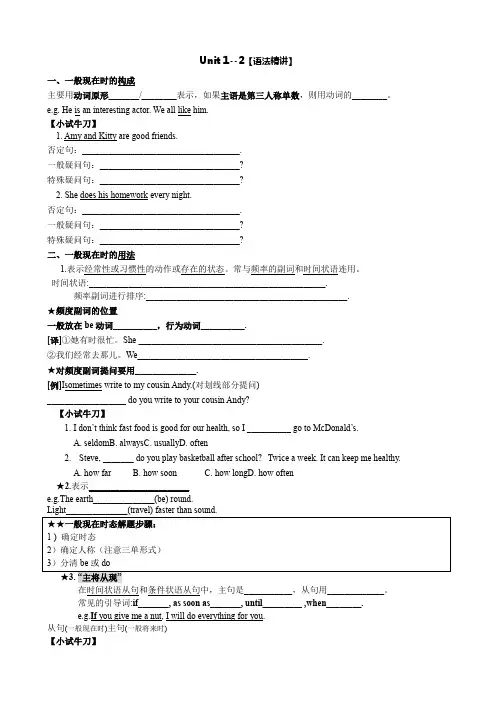
Unit 1--2【语法精讲】一、一般现在时的构成主要用动词原形_______/________表示,如果主语是第三人称单数,则用动词的________。
e.g. He is an interesting actor. We all like him.【小试牛刀】1. Amy and Kitty are good friends.否定句:____________________________________.一般疑问句:________________________________?特殊疑问句:________________________________?2. She does his homework every night.否定句:____________________________________.一般疑问句:________________________________?特殊疑问句:________________________________?二、一般现在时的用法1.表示经常性或习惯性的动作或存在的状态。
常与频率的副词和时间状语连用。
时间状语:______________________________________________________.频率副词进行排序:______________________________________________.★频度副词的位置一般放在be动词__________,行为动词__________.[译]①她有时很忙。
She __________________________________________.②我们经常去那儿。
We_______________________________________.★对频度副词提问要用______________.[例]Isometimes write to my cousin Andy.(对划线部分提问)__________________ do you write to your cousin Andy?【小试牛刀】1. I don’t think fast food is good for our health, so I __________ go to McDonald’s.A. seldomB. alwaysC. usuallyD. often2. --Steve, _______ do you play basketball after school?--Twice a week. It can keep me healthy.A. how farB. how soonC. how longD. how often★2.表示_______________________e.g.The earth______________(be) round.在时间状语从句和条件状语从句中,主句是___________,从句用_____________。
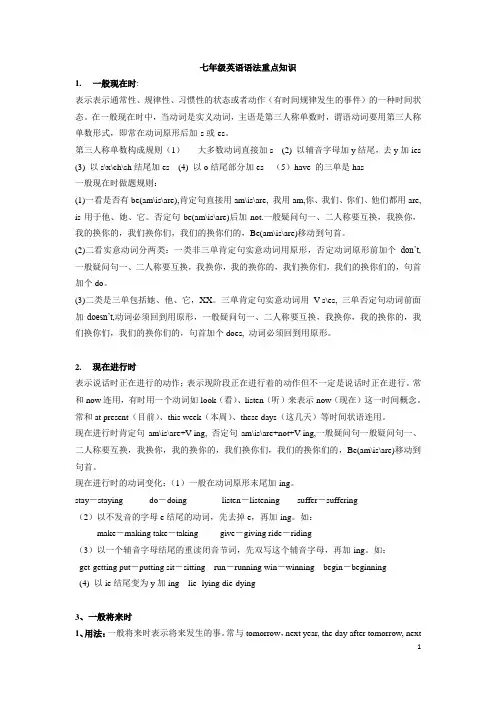
七年级英语语法重点知识1. 一般现在时:表示表示通常性、规律性、习惯性的状态或者动作(有时间规律发生的事件)的一种时间状态。
在一般现在时中,当动词是实义动词,主语是第三人称单数时,谓语动词要用第三人称单数形式,即常在动词原形后加-s或-es。
第三人称单数构成规则(1)大多数动词直接加s (2) 以辅音字母加y结尾,去y加ies (3) 以s\x\ch\sh结尾加es (4) 以o结尾部分加es (5)have 的三单是has一般现在时做题规则:(1)一看是否有be(am\is\are),肯定句直接用am\is\are, 我用am,你、我们、你们、他们都用are, is用于他、她、它。
否定句be(am\is\are)后加not.一般疑问句一、二人称要互换,我换你,我的换你的,我们换你们,我们的换你们的,Be(am\is\are)移动到句首。
(2)二看实意动词分两类:一类非三单肯定句实意动词用原形,否定动词原形前加个don’t,一般疑问句一、二人称要互换,我换你,我的换你的,我们换你们,我们的换你们的,句首加个do。
(3)二类是三单包括她、他、它,XX。
三单肯定句实意动词用V-s\es, 三单否定句动词前面加doesn’t,动词必须回到用原形,一般疑问句一、二人称要互换,我换你,我的换你的,我们换你们,我们的换你们的,句首加个does, 动词必须回到用原形。
2. 现在进行时表示说话时正在进行的动作;表示现阶段正在进行着的动作但不一定是说话时正在进行。
常和now连用,有时用一个动词如look(看)、listen(听)来表示now(现在)这一时间概念。
常和at present(目前)、this week(本周)、these days(这几天)等时间状语连用。
现在进行时肯定句am\is\are+V-ing, 否定句am\is\are+not+V-ing,一般疑问句一般疑问句一、二人称要互换,我换你,我的换你的,我们换你们,我们的换你们的,Be(am\is\are)移动到句首。
译林牛津七年级上学期英文语法总结一、Present Simple TensePresent Simple Tense(一般现在时)用于表示经常性的动作、惯、真理或常识。
句子结构为主语 + 动词原形(第三人称单数加-s)。
例如:- I often play basketball after school.- He goes to the gym three times a week.- Water boils at 100 degrees Celsius.二、Past Simple TensePast Simple Tense(一般过去时)用于表示过去发生的动作或存在的状态。
句子结构为主语 + 动词过去式。
例如:- She watched a movie last night.- They visited their grandparents during the summer vacation.- Peter knew the answer to the question.三、Present Continuous TensePresent Continuous Tense(现在进行时)用于表示现在正在进行的动作。
句子结构为主语 + am/is/are + 动词-ing。
例如:- I am studying for the English exam right now.- They are playing soccer in the park.- She is reading a book at the moment.例如:- This book is more interesting than that one.- Tom is taller than his brother.- The red car is faster than the blue one.五、SuperlativesSuperlatives(最高级)用于表示多个事物中最高程度的特征。
译林版牛津英语七年级上册期末复习知识点总结译林版牛津英语七年级上册期末复知识点整理Units1--4重点知识点总结n.名词v.动词vt.及物动词vi.不及物动词adj.形容词adv.副词prep.介词pron.代词conj.连词1、喜欢like / love / enjoy / be XXX (痴迷于)/ have fun / have a good time +doing sth.动词+doing的还有Go XXX good at doing sth./ do well in doing sth. How/what about doing XXX.2、“四大看”read vt.看读物(XXX等)look vi.瞧常用短语look at/for/around/after/out/over/up see vt.看见,强调结果I can see you.watch vt.带有欣赏性的观看watch TV/ a film / a football game3、“五大衣着”Put on夸大“穿上”的举措XXX ____XXX.Wear强调“穿着”的状态;进行时态表示暂时的情况XXX (1)dress sb. (2) dress oneself (3) dress up as (4) get dressedIn (穿戴)后接颜色(或衣服),表示状态look!Lucyis_____a red XXX后接人指衣服穿在某人身上看出区别来。
XXX red XXX.4、“四大花费”XXX:sb.(人)+ XXX.sb.(人)+ spend +工夫/款项+(in) XXX:sb.(人)+pay +款项+for sth. cost:sth.(物) + cost + sb.+款项XXX工夫XXX:it XXX sb. +时间+ to do sth.5、“三大地点副词”Home / there /here前不加任何的介词welcome home / come here / go there6、“三大使役动词”Make sb. do sth./ have sb. do sth. / let sb.do sth.7、见面打招呼用语(1)Nice to meet you . (2) Glad to meet you . (3) How are you ? (4) How are you doing ?(5)How is it going ?(6)How is everything going? (7) What’s up?8、基数词+year(s)+old表示“…岁”提问用“how old”名词性短语数词-year-old也表示年龄,但其为形容词性短语“前有冠词后有名(词)”Eg. Helen is 11 years old = Helen is an 11-year-old girl.9、Let’s与let us的区别Let’s do sth.指包孕听者(对方)和说者(我们)都在内,透露表现发起Let us do sth.指“让(答应)我们做某事”而听者(对方)不做,只要“我们”做10、play+the+乐器类名词e.g. Play the pianoPlay +球类运动play+ football / play cards / play chess11、She comes from Shanghai= She is from Shanghai .注:如何提问Shanghai及如何改一般疑问句12、be good at =do well in = be clever at = study sth. wellBe good at (反) be bad at do well in (反) be poor in13、介词over的用法(1)”在…正上方”There is a bridge over the river. (2)”超出”A plane flies over the house(3)”跨越”There are over 20 boys in this class. (4)”竣事”Class is over! / Game is over.14、every one与everyone辨析区分(1)Every one能够与of连用,而everyone却不克不及与of连用Eg.every one of the children XXX(2) everyone只指人=everybody而every one既指人又可指物配合点:谓语动词都要用“三单”15、family的用法:“家庭”作为团体谓语动词用“单数”He has a big family.“家人”夸大成员,是复数寄义,谓语动词用“真相”My family are at home.拓展:个人名词有people、class、police、sheep、deer、furniture等16、all/ both/ each/every/neither/ either的用法all(1)三者或三者以上“所有、都”(2)all + the +名词(all the afternoon = the whole afternoon)(3)all放在行为动词前,名词前;be动词后(4) all of +宾格/名词复数Both(1)两者都(2)后可跟of +宾格/名词复数Both sides of XXX指两个或两个以上“每个”个别Each side of the XXX.Every指许多人或事物的“全体”后接名词单数Every student is here .所有人都在。
译林版牛津初中英语七年级上册全册各单元短语、句型归纳整理Unit 1 This is me!短语:1.look after sb。
- take care of someone2.some of the new students - a few of the new studentsone of + plural countable noun - one of the。
many of + plural countable noun - many of the。
much of + uncountable noun - much of the。
3.love doing。
- enjoy doing。
like doing。
- like to do。
enjoy doing。
- love to do。
4.let sb。
do sth。
- allow someone to do something5.make sb。
do sth。
- force someone to do somethingThe verb "let" and "make" are followed by the base form of the verb with "to" as the object complement.6.like sports - enjoy sports7.after class - after the classin class - during the class8.be good at (doing)。
- be skilled at (doing)。
9.meet my new friends - meet my new classmates10.over there - in that n11.tell sb。
about sth。
- inform someone about something12.Oh。
牛津译林版七年级英语上册Unit7语法知识点汇总PartI 、some 与anysome意为“一些”、“几个”,通常用于肯定句中。
现将其主要用法归纳如下:一、some作形容词用时,可以修饰复数可数名词,也可以修饰不可数名词。
例如: There are _________ students in the classroom. 教室里有几个学生。
There ______ some milk in the glass. 杯子里有一些牛奶。
二、some作代词用时,可在句中作主语或宾语。
例如: Some of the boys _______ playing games now. 有几个男孩现在正在做游戏。
I have no paper. Please give me __________. 我没有纸了,请给我一些吧。
三、some有时也可以用在疑问句中,表示请求、建议,并期望得到对方的肯定回答。
它也可以用于反问句中。
例如: Can you give me________ money? 你能给我一些钱吗? Would you like________ more rice? 再来点米饭好吗? Why don’t you buy __________ flowers for her? 你为什么不给她买些花呢?any也有“一些”的意思,但它常用在否定句、否定答语或疑问句中。
其具体用法如下:一、any作形容词用时,可以修饰可数名词的单数或复数,也可以修饰不可数名词。
例如: Do you have________ questions to ask? 你有什么问题要问吗? There isn’t ________ water in this bottle. 这个瓶子里没有水。
二、any作代词用时,也可用于肯定句中,表示“任何”的意思,起强调作用。
例如: You may take _______ of them. 这些东西,你随便拿哪个都行。
牛津译林版七年级上册英语Unit1语法总结1. 一般现在时一般现在时表示经常性、惯性或普遍性的动作或状态。
其构成为:主语 + 动词原形 (+ 其他补充成分)。
例句:- I play basketball every day.(我每天打篮球。
)- She likes reading books.(她喜欢读书。
)2. 句型:主语 + be + 形容词这种句型用来表达主语的状态或特征。
例句:- The weather is sunny today.(今天天气阳光明媚。
)- He is tall and handsome.(他又高又帅。
)3. 一般过去时一般过去时用来表示过去某个时间发生的动作或存在的状态。
其构成为:主语 + 动词过去式 (+ 其他补充成分)。
例句:- They went to the park yesterday.(他们昨天去了公园。
)- We lived in Shanghai five years ago.(我们五年前住在上海。
)4. 句型:主语 + be + 动词-ing这种句型用来表示主语正在进行的动作。
例句:- I am studying English now.(我现在正在研究英语。
)- They were playing soccer in the park yesterday.(他们昨天在公园踢足球。
)5. 一般将来时一般将来时用来表示将来某个时间将要发生的动作或存在的状态。
其构成为:主语 + will + 动词原形 (+ 其他补充成分)。
例句:- We will have a party next week.(下周我们将举行一个派对。
)- She will visit her grandparents tomorrow.(她明天将去看望她的祖父母。
)6. 句型:主语 + be + going to + 动词原形这种句型用来表示主语打算或计划将要发生的动作。
例句:- I am going to meet my friends this afternoon.(今天下午我将去见我的朋友。
7A语法总结一、一般现在时第一,动词be 的三变化am is are. 我(I)用am ,你(you)用are ,is 用于他(he)她(she)它(it),单数名词用is,复数名词都用are句型结构:1、肯定句:主语+am\is\are … It is a football.2、否定句:主语+am\is\are+not… It is not a football.3、一般疑问句:Am\Is\Are+主语+其他?Is it a football? 回答Yes, it is. No, it isn’t4、特殊疑问句:疑问句+am/is/are +主语+其他?What’s your name?用be 动词的适当形式填空1、She ________ my cousin. Her name _______ Li Jie.2、Tom and I ________ good friends3、What _____ this in English?It ______ a book4、________ you Jack? Yes, I _______5、What ________ those? They ______ his notebooks.第二,行为动词的一般现在时行为动词的一般现在时的构成:主语+行为动词+(其他)当主语为第三人称单数(he, she, it)时,谓语动词也要用单数形式。
用好一般现在时,时间状态需牢记;主语人称是三单,动词要把-s/-es 添;基本用法要记清,状态习惯经常性。
行为动词的一般现在时的变化1.否定句:主语+ don’t/doesn’t + 动词原形+其他I don’t like bread.He doesn’t often play football.2.一般疑问句:Do/Does + 主语+动词原形+其他Do you often play football? Yes, I am /No, I am notDoes he often play football? Yes, he does/ No, he doesn’t3、特殊疑问句:特殊疑问句+一般疑问句?When do you go to school? I go to school at seven o’clock.动词的三单形式的变化:动词三单现在时,一般在词尾加SS,x,ch,sh,在词尾,直接加上-es词尾若是字母o ,加上-es 不用愁。
词尾是“辅音字母+y” ,先变y为i, 后边再加-es巩固练习:用动词的适当形式填空1.I like ____________ (swim).2.He _________(read) English every day.3.We _________(go)to school at seven in the morning.4.Mike________(go)to school at seven in the morning.5.My mother________(like) ______(go) shopping.6.I can ________(draw) many beautiful pictures.7.She_________(make) a model plane.8.Do you ________(like)_________(run)?9.Does he_________(like)_________(jump) ?10.Does Nancy_________(grow)flowers on Saturday ?11.The teachers________(like)___________(dance).12.The teacher________(like)____________(dance).13.The students___________(speak) English in class.14.The student_________(speak) Chinese after class.15. Let's____________and play football . ( go )二、人称代词人称代词主格:作主语,表示谁怎么样了、干什么了。
I am a teacher. You are student. He is a student, too.We/You/They are students.人称代词宾格作宾语,表示动作行为的对象。
Give it to me.??Let’s go (let’s =let us)三、物主代词表示所有关系的代词叫做物主代词,也可叫做代词所有格。
物主代词分形容词性物主代词和名词性物主代词二种,其人称和数的变化见下表。
形容词性物主代词(my/your/his/her/its/our/their)+名词而名词性物主代词则相当于形容词性物主代词+名词,故其后不必加名词。
如:Is this your book? No,,it isn’t,it’s hers(her book)This pen is mine.巩固练习:1. __________ is my aunt. We often visit __________. ( she )2. China is a developing country. _________is in the east of Asia. ( its )3.What day is __________ today? — __________ is Thursday. (its)4. We are going to Paris to stay with a French friend of ____ . (we )5. I own a blue bike. The red one isn’t __________. ( I )6. These new houses are so nice. __________ are very expensive.( them )7. The fishermen caught a lot of fish, didn’t __________? ( them )8.Ling Ling is a girl. ____ studies in a primary school. ______ brother lives with____ and helps____ with______ lessons. ( she )9. Mike is my classmate. ____ is good at English . ( his )10. Kate wants a glass of milk. Will you pass it to ____ ? ( she )11. What’s the weather like today ? ____ is cloudy. ( its )12. I ate all ____ sandwiches yesterday.( I ) Can I have one of ____ ? ( you )13. George has lost ____ ( his ) pen. Ask Mary if(是否)she will lend him ____ . ( she )14.Jack has a dog and so have I. ____ ( he ) dog and ____ ( I ) had a fight (打架).15. The teacher wants you to return that book of ____ ( he )四,介词in一般在“上午”“下午”“晚上”,还有时间段,年、月、季节;On 指特定的某一天,日期,星期和具体的节日At 用在时刻前,还有正午,午夜和表示一段时间的节日巩固练习:1.?Children?get?gifts?____?Christmas?and?____?their?birthdays.?A.?on;?on?????B.?at;?on????C.?in;?in????D.?in;?on??2.----There?is?nothing?____tomorrow?afternoon,?is?there??-----No.?We?can?have?a?game?of?table?tennis.??A.?on???????B.?in??????C.?out?????D.?up???3.?A?lot?of?students?in?our?school?were?born____March,?1981.?A.?in????????B.?at????????C.?on??????D.?since???4.?He?suddenly?returned____?a?rainy?night.?A.?on??????B.?at??????C.?in??????D.?during??5.?My?grandfather?was?born____Oct.?10,?1935.?A.?on???????B.?in???????C.?at????????D.?of??6.?The?train?is?starting___five?minutes.?A.?in????????B.?at??????C.?for???????D.still??7.?Mike?does?his?exercises?____?seven?_____?the?evening.?A.?on;?to????????B.?at;?in????????C.?by;?of???????D.?at;?on??8.?Children?wake?up?very?early____the?morning?of?Christmas?Day.?A.?in?????????B.?on????????C.?for???????D.?at???9.?____?a?cold?winter?morning,?I?met?her?in?the?street.?A.?In????????B.?On???????C.?At???????D.?For??10?.It?happened?to?be?very?cold____?the?morning?of?our?sports?meeting.?A.?at????????B.?on????????C.?with??????D.?of??11.?Why?did?you?get?up?so?early?___?this?morning.?A.?on????????B.?/????????C.?at????????D.?in??12.?He?went?to?Shanghai___?September?3rd,?1991?and?came?back___?a?cold?morning ?last?year.?A.?in;?on???????B.?on;?in???????C.?on;?on???????D.?in;?in??13.?Lucy?was?born____?the?night?of?May?12,?1984.?.?...?A.?on??????????B.?in?????????C.?at?????????D.?to??14.?Mrs.?Brown?came?to?China?____?1996A.on?????????B.?of?????????C.?to,????????D.?in??15?___?the?morning?of?November?20,?1915,?the?workers?came?to?Chicago?to?show?th eir?mourning?of?Joe?Hill.?A.?On????????B.?In?????????C.?On???????D.?At五、频度副词从频率最大到频率最小依次为:always, usually, often, sometimes, seldom, never.对频率副词提问要用how often巩固练习:1. -Does Alice often work until 2 a.m.?-No, she ________ does.A. nearlyB. certainlyC. seldomD. always2.–I didn’t know you take a bus to school.-Oh, I ______ take a bus, but it is snowing today.A. hardlyB. neverC. sometimesD. usually3. -Were you often late for school last term, Tom?-No, _______. I got to school early every day.A. AlwaysB. UsuallyC. SometimesD. Never4.–How often do you go to a concert?-_______ ever. I’m not interested in that at all.A. UsuallyB. HardlyC. Almost5. -John sings so well. Has he ever been trained?-No. He learns all by himself. He ________ goes to any training class.A. usuallyB. oftenC. neverD. even6.–Miss Gao is very popular with her students.-Yes. Her classes are ______ lively and interesting.A. seldomB. neverC. sometimesD. always7.We are going to have a party ________ next week.A. sometimeB. some timeC. sometimesD. some times8. Sandy is so careful that she ________ makes mistakes in her homework.A. usuallyB. seldomC. oftenD. Always9.—Please drive ______ when you pass a school.—OK.A. nearlyB. earlyC. slowlyD. really10.—Have you ever been to Disneyland?—No, ______.I hope I can go there next year.A. alwaysB. sometimesC. neverD. often11.—How often do the students play sports?A. Twice a dayB. Since last nightC. For two hoursD. A month ago12. I play basketball every day because I want to play as ______ as Yao Ming.A. wellB. betterC. best13. Mike hurt his back seriously and can_____ get out of bed without help.A. quicklyB. easilyC. nearlyD. hardly14.— Did you go to the cinema to see 3D Titanic last night?—No, I go to the cinema. The tickets are too expensive.A.hardlyB. nearlyC. stillD. Only15. — How often do you exercise?—ever. Because I am very busy with my work.A. HardlyB. NearlyC. AlwaysD. Almost六、特殊疑问句语法:特殊疑问句定义:特殊疑问句是用来对句子的某一部分提问的疑问句,以疑问词开头结构:特殊疑问句的基本结构疑问词+be动词/助动词/情态动词+主语+谓语动词特殊疑问词分类:疑问代词有:what(什么), which(哪一个), who(谁), whose(谁的)疑问副词有:where(哪里), when(什么时候), why(为什么), how(怎么样)疑问词还可以与某些单词搭配,构成疑问词短语,如:what time(什么时间), what colour(什么颜色), how many(多少), how much (多少,多少钱)how long(多长), how often(多久一次), how old(几岁), how tall(多高)巩固练习:1.They bought a new bike yesterday.____________________________________________________2.She is my teacher.____________________________________________________3.It is my coat .____________________________________________________4.I get up at six .____________________________________________________5.I am from Hubei .____________________________________________________6.I went to school late because I got up late.____________________________________________________7. They boy under the tree is Jack.____________________________________________________8. The yellow cat is Sammy?____________________________________________________9. There are six boxes on the desk?____________________________________________________10. It is windy ._____________________________________________________11. There are six boxes on the desk?____________________________________________________12. My bag is red .______________________________________________________13. The book is Li Hua’s.______________________________________________________15. They are five yuan .______________________________________________________八,冠词的用法定冠词a,an 的用法元音因素前用“an” an hour 一个小时 a useful book 一本有用的书巩固练习:1.?I?read?______story.?It?is?______interesting?story.???A.?a,?an??????????B.?a,?a??????????C.?the,?the??????????D.?/,?an?2.?Britain?is?__?European?country?and?China?is?___?Asian?country.???A.?an,?an?????????B.?a,?a??????????C.?a,?an????????????D.?an,?a?3.?______China?is?_____?old?country?with?_____?long?history.???A.?The,?an,?a??????B.?The,?a,?a???????C.?/,?an,?the????????D.?/,?an,?a?4.?_____elephant?is?bigger?than?______?horse.???A.?/,?/????????????B.?an,?a??????????C.?An,?a???????????D.?/,?the?5.?We?always?have?______rice?for?______lunch.???A.?/,?/????????????B.?the,?/??????????C.?/,?a????????????D.?the,?the?6.?It?took?me?______?hour?and?_____?half?to?finish?______?work.???A.?a,?a,?a??????????B.?an,?a,?a????????C.?an,?a,?the???????D.?an,?a,?/?7.?______?doctor?told?me?to?take?______?medicine?three?times?______day,?stay?in?__ ___bed,?then?I?would?be?better?soon.???A.?/,?a,?a,?the???????B.?A,?the,?the,?/?????C.?The,?the,?a,?/????D.?A,?/,?a,?/?8.?There?is?____?picture?on?____?wall.?I?like?____?picture?very?much.???A.?a,?the,?the???????B.?a,?the,?a???????C.?the,?a,?a????????D.?a,?an,?the?9.?January?is?______first?month?of?the?year.???A.?a??????????????B.?/?????????????C.?an????????????D.?the?10.?Shut?_____door,?please.???A.?a??????????????B.?an????????????C.?the????????????D./?11.?Einstein?won?_____?Nobel?Prize?in?Physics?in?1921.???A.?a???????????????B.?an???????????C.?the????????????D.?/?12.?What?____?fine?day?it?is?today!?Let's?go?to?the?Summer?Palace.???A.?a???????????????B.?an????????????C.?the???????????D.?/?13.?I?like?music,?but?I?don't?like?____?music?of?that?TV?play.???A.?a???????????????B.?an????????????C.?the???????????D.?/?14.?____?girl?over?there?is?____?English?teacher.???A.?The,?an??????????B.?A,?/???????????C.?The,?/?????????D.?A,?a?15.?It's?____?exciting?way?to?shop?on?the?Net.???A.?a???????????????B.?an?????????????C.?the???????????D.?/?七,不定代词的运用Some 用于肯定句any 用于一般疑问句和否定句巩固练习:用some和any填空.?1.??????I?have?_____________good?friends?in?my?class.?2.??????Is?there?____________water?in?the?bottle???3.??????Do?you?have?____________________money???4.They?don’t?have?______________time?to?go?there.?5.There?are?________________cakes?on?the?table.6.I?don’t?have?__________________milk?for?breakfast.?7.Does?he?have?______________brothers?or?sisters??8.There?aren’t?_____________pictures?on?the?wall.?9.Can?I?ask?____________________questions???10.??Are?there?________flowers?in?you?classroom????No,?there?aren’t?_________.?11.??We?have?____________apples,?but?we?don’t?have?____________pears.?12.??Is?there?__________orange?juice?in?the?fridge???Yes,?there?is?____________.?13.??I?can?speak?____________English,?but?I?can’t?speak?___________Russian.?14.??Do?they?have?____________color?pencil???No,?they?don’t?have?___________.?15.??There?isn’t?____________meat?at?home.?I?must?go?and?buy?____________.? There is +可数名词单数/不可数名词There are +可数名词复数形式巩固练习:1.There ______ any rice in the bowl.A. areB. IsC. isn’tD. aren’t2. There ______ many apples on the tree last year.A. have beenB. wereC. areD. is3. There ______ a film tomorrow evening.A. will haveB. haveC. is going to beD. has4. There is some milk in the bottle, ______?A. isn’t thereB. aren’t thereC. isn’t itD. are there5. how many boys ______ there in the Class One?A. beB. isC. areD. am6. There ______ a lot of good news in today’s newspaper.A. isB. areC. wasD. were7. There ______ pencil-box, and some flowers on the desk.A. is aB. are someC. has aD. have some8. There ______ an apple and ten bananas in the basket.A. areB. isC. hasD. have9. ______ any flowers on both sides of the street?A. Is thereB. Are thereC. HasD. Have10. There is little water n the glass, ______?A. isn’t thereB. isn’t itC. is itD. is there11. What did you see in the basket then? There ______ a bottle of orange and some oranges.A. isB. areC. wasD. were12. ______ is there on the table?A. How many applesB. How much breadC. How much breadsD. How many food.13.There ______ something wrong with our classroom.A. areB. hasC. isD. have14.There is some ______ on the table.A. appleB. orangeC. cakeD. sandwich15. There is little water in the glass, ______?A. isn’t thereB. isn’t itC. is itD. is there八、现在进行时1.定义:现在进行时表示正在发生或进行的动作。